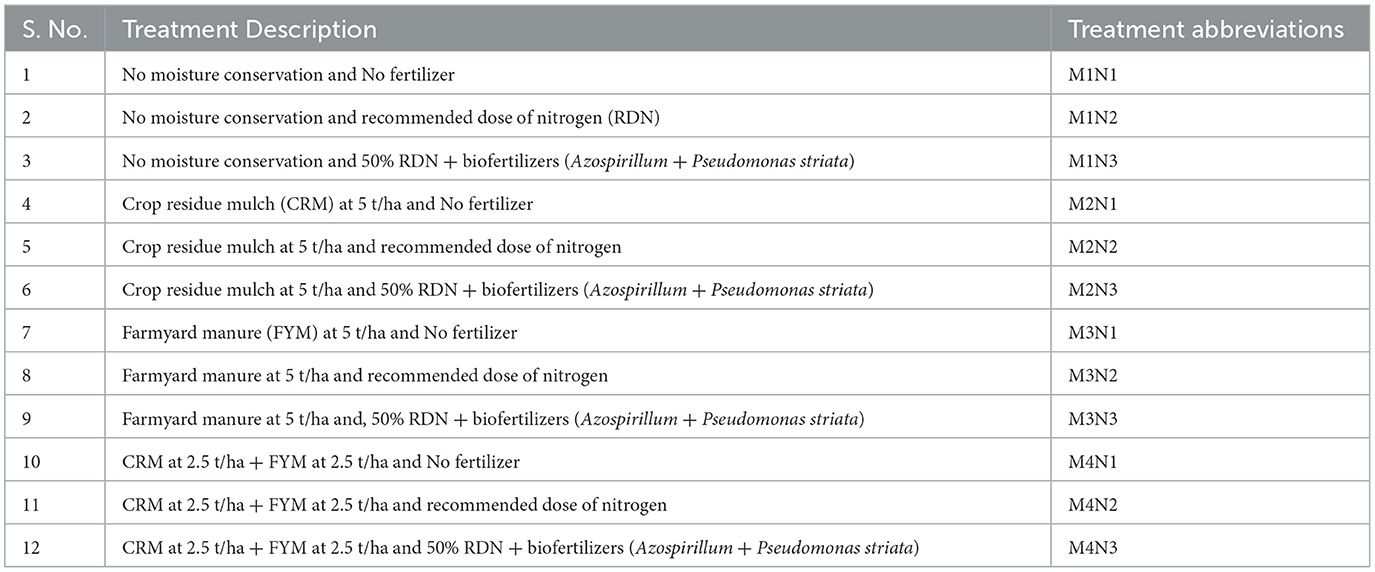- 1Division of Agronomy, ICAR-Indian Agricultural Research Institute, New Delhi, India
- 2ICAR-Indian Agricultural Statistics Research Institute, New Delhi, India
Moisture- and nutrient-stress substantially limits the productivity and profitability under rainfed environments; therefore, strategic nutrient and moisture management is obligatory. Present study aims to assess the impacts of diverse moisture-conservation and nutrient-management protocols on yield-stability, system-sustainability, and soil-health in rainfed pearl millet–mustard rotation. Four moisture-conservation systems: control (M1), crop-residue mulch (CRM: 5 t/ha, M2), farmyard manure (FYM: 5 t/ha, M3), and a combination of CRM 2.5 t/ha + FYM 2.5 t/ha (M4); and three nutrient-management practices: control [N1], recommended dose of nitrogen (RDN: 60-40-40 kg/ha, N, P2O5 and K2O, respectively) [N2], and 50% RDN + biofertilizers (Azospirillum + Pseudomonas striata) [N3] were evaluated in split-plot design for 6 years. The study revealed that the M4 and M3 treatments significantly improved pearl millet yield (64.4%−70.7%), mustard yield (25.8%−31.6%), system productivity (35%−41.4%), rainwater-use efficiency (RUE, 35.2%−40.8%), and sustainable yield index (65.5%−81.6%) over control. The system productivity was highest in 2014–15 (6.06 t/ha) and 2019–20 (5.93 t/ha). The RUE reached maxima during 2017–18 (7.27 kg/ha-mm). The M4N3 combination resulted in greatest system productivity (7.64 t/ha), higher available NPK (200, 16.03 and 259.2 kg/ha, respectively) content in top-soil and improved soil microbial-enzymatic activity (dehydrogenase, acid phosphatase, alkaline phosphatase and protease). The integrated approach of CRM + FYM coupled with 50% RDN + Azospirillum + Pseudomonas biofertilizers offers a viable solution for sustainably enhancing productivity in the pearl millet–mustard system under water-limited ecologies. Our studies indicate the potential of adopting organic nutrient-cum-moisture management along with conventional synthetic fertilizers in sustaining the productivity and soil-health in fragile rainfed ecosystems.
1 Introduction
Rainfed agriculture, which encompasses over 1.13 billion hectares globally, plays a pivotal role in ensuring world food security, contributing to more than 60% of total food production. Likewise, In India also, nearly 48% of the cropland areas are rain-dependent (FAO, 2024). However, the rainfed drylands are characterized by alarmingly low and unstable yields, primarily owing to extreme rainfall variability and suboptimal soil nutrient status. Diversifying crops in rainfed-drylands can mitigate the risk of complete crop failures, particularly during frequent droughts. However, soil-moisture stress remains a notable yield-limiting factor, leading to yield losses up to 50% across diverse agro-ecologies (Choudhary et al., 2019). Numerous factors contributing to water deficits in rainfed agro-ecologies, including inadequate and erratic rainfall patterns, low moisture-holding capacity of soils, and high evapo-transpiration losses (Louhar et al., 2020). Despite the inherent challenges, the importance of rainfed agriculture remains paramount as nearly two-thirds of global food production originates from crops cultivated in water-stressed environments, specifically in the emerging economies (Srinivasarao et al., 2015). Furthermore, climate change is anticipated to exacerbate drought's adverse effects on crop production, specifically in the rainfed drylands (Dass and Bhattacharyya, 2017). Nutrient deficiency is widespread in Indian drylands, as nearly 89%, 80%, and 50% of the rainfed-drylands are deficient in N, P, and K respectively. Likewise, 41%, 48%, and 12% of the soils are low in S, Zn, and Fe content (Srinivasarao et al., 2015). Thus, developing and implementing effective strategies to enhance water and moisture management and enrich the soil fertility in rainfed systems is crucial for ensuring future food security.
Pearl millet [Pennisetum glaucum (L.) R. Br.] is a highly nutritious drought-tolerant cereal, largely a crop of Asian and African arid and semi-arid tropics. Its resilience to moisture stress, especially during mid- and terminal-stages of ontogeny, makes it a reliable crop when other cereals fail to produce adequate yields under climatic adversities (Dass and Bhattacharyya, 2017; Kumar et al., 2021). With increasing instances of seasonal rainfall variability, terminal heat-stress, and extreme weather events, pearl millet is gaining renewed attention due to its ability to sustain productivity under harsh environments. Considering the importance of millets in nutritional security, the United Nations declared 2023 as the International Year of Millets. Additionally, owing to their other characteristics like low environmental footprints in their production, resilience to changing climate and nutrient rich grains at affordable prices, millets are known for accomplishing sustainable development goals (SDGs), primarily SDG 2 of zero hunger, SDG 3 for good-health and wellbeing, SDG 12 associated with sustainable consumption and production and SDG 13 related to climate action (Sahoo and Mahapatra, 2023).
In the agro-ecosystems with well-distributed rainfall, double cropping systems, including the cultivation of pulses, oilseeds, and vegetables during the post-monsoon (rabi) season, are commonly adopted. For instance, growing high-value crops like pulses or oilseeds after harvesting of rainfed pearl millet can enhance farm incomes (Biswas, 2019). Certain crops like Indian mustard [Brassica juncea (L.) Czernj and Coss.] can withstand moisture stress to a significant extent, and is frequently grown after pearl millet harvesting due to its adaptability to residual soil moisture from the rainy season (Bana et al., 2023a).
The pearl millet–mustard cropping system is particularly common in north-western India (Bamboriya et al., 2017). Mustard is an essential winter oilseed crop, contributing significantly to India's rural economy. For the 2023–24, mustard production in India reached to the new record of 13.3 million tons, from an acreage of 10 million hectares (Anonymous, 2024). To meet the burgeoning demand for edible oils and reduce massive import expenditures of the country, strategies that improve mustard productivity are critical (Patel et al., 2024). Fluctuations in mustard yield levels under specific agro-climatic scenarios have been observed and are influenced by various moisture and nutrient regimes of the soil (Bamboriya et al., 2017). Mustard requires relatively large quantity of nutrients to achieve its yield potential, and inadequate nutrient supply often results in sub-optimal and inconsistent productivity (Singh and Singh, 2015). Furthermore, quantum of soil moisture directly influences the availability and uptake of nutrients (Chaudhari et al., 2018). Hence, ensuring optimal supply of moisture coupled with matching nutrient supply is crucial for rainfed mustard to achieve its yield potentials (Kumar et al., 2021; Pratap et al., 2022). Earlier research indicated that integrated approaches of nutrient management enhanced the productivity, nutritional profile and profits in the cereals and oilseed-based systems (Jat et al., 2023). Likewise, in-situ moisture conservation aided productivity, profitability, nutritional quality and resource use-efficiency improvements have been noted from various studies (Ghosh et al., 2019; Jinger et al., 2024, 2025). It is well established that enhanced aridity reduces nutrient availability, resulting in sub-optimal yields (Wang and Wen, 2023). However, no much information is available on adoption of long-term conjunctive and complementary moisture and nutrient management strategies under drylands.
In nutshell, to achieve twin objective of maintaining stable system productivity and improving soil-health of the rainfed pearl millet–Indian mustard production system, it is obligatory to adopt moisture conservation strategies which not only retain soil moisture but also contribute to soil fertility (Bana et al., 2023b). Likewise, nutrient management must also be tailored to ensure balanced nutrient supply while retaining adequate soil moisture, specifically in the rhizospheric zone (Mozafari et al., 2020). Although chemical fertilizers have immensely contributed in enhancing yields, however, their rising costs, deleterious soil-health effects mainly due to their imbalance use, and relatively greater environmental footprints have lately increased the interest in inclusion of organics in nutrient management schedules. The application of organic materials promotes the build-up of soil humus, improving physical and biological soil properties (Garg et al., 2022). The appropriate blend of organic and inorganic fertilizers can enhance soil fertility and sustain productivity, while reducing carbon footprints in intensive cropping systems (Singh et al., 2022; Jaga and Tripathi, 2011). Integrated nutrient management—utilizing organic materials with synthetic fertilizers—has been shown to improve soil health and enhance crop yields in the long-term experimentations (Allohverdi et al., 2021). However, the long-term impact of integration of moisture and nutrient management strategies on the pearl millet–mustard cropping system productivity and soil microbial activity in rainfed conditions has not been extensively studied. In the like manner, information on the temporal variations in the productivity and water use-efficiency vis-à-vis seasonal rainfall pattern with respect to year × treatment × moisture-conservation × crop nutrition interactions are not available. This 6-year study aims to assess the effects of moisture conservation and nutrient management protocols on crop productivity, system sustainability, yield stability and soil health in the pearl millet–mustard rotation under rainfed ecologies of NWR of India. Furthermore, using GGE biplot technique, the investigations aimed at, specifically identifying appropriate moisture-conservation and nutrition nexus to achieve greater yield stability in the rainfed production systems. To see the year × treatment × moisture-conservation × nutrition interactions was the other objective of the study. We hypothesized that long-term moisture conservation practices coupled with organic nutrient management strategies may enhance the soil fertility and stabilize the productivity levels in fragile rainfed environments.
2 Materials and methods
2.1 Experimental location
A fixed-plot long-term field experiment was conducted over six consecutive years (12 cropping seasons), from the kharif of 2014–15 to the rabi of 2019–20, at research farm of the ICAR-Indian Agricultural Research Institute, New Delhi, India (28° 38′ N latitude, 77° 09′ E longitude, and 228 meters above sea level). The geographical region is meteorologically identified as sub-tropical, semi-arid climate, featuring hot, dry summers and cool winters, typical of the north-western Indo-Gangetic Plains. The hottest months, May and June, experienced mean daily maximum temperatures ranging from 38°C to 48°C, while January, the coldest month, recorded mean daily minimum temperatures between 4°C and 6°C. The region receives an average annual rainfall of approximately 774.4 mm, the majority of which occurs during the south-west monsoon season (July to September). Detailed data on the seasonal and annual weather scenarios during the study period are provided in Figure 1, highlighting the inter-annual variability that can influence crop performance. The soil at the experimental site is classified as Typic Haplustept, according to the Libohova et al. (2018). It is sandy loam in texture, comprising 61.48% sand, 12.66% silt, and 25.86% clay. The soil exhibits slightly alkaline characteristics, with a pH of 7.6. In terms of fertility, the soil is low in organic carbon content (0.40%) and available nitrogen (175.4 kg N/ha), while it has medium levels of available phosphorus (12.8 kg P2O5/ha) and potassium (178.8 kg K2O/ha) in 0–15 cm soil layer. These baseline soil characteristics were determined through standard soil analysis procedures as described by Rana et al. (2014), prior to the initiation of the experimentation.
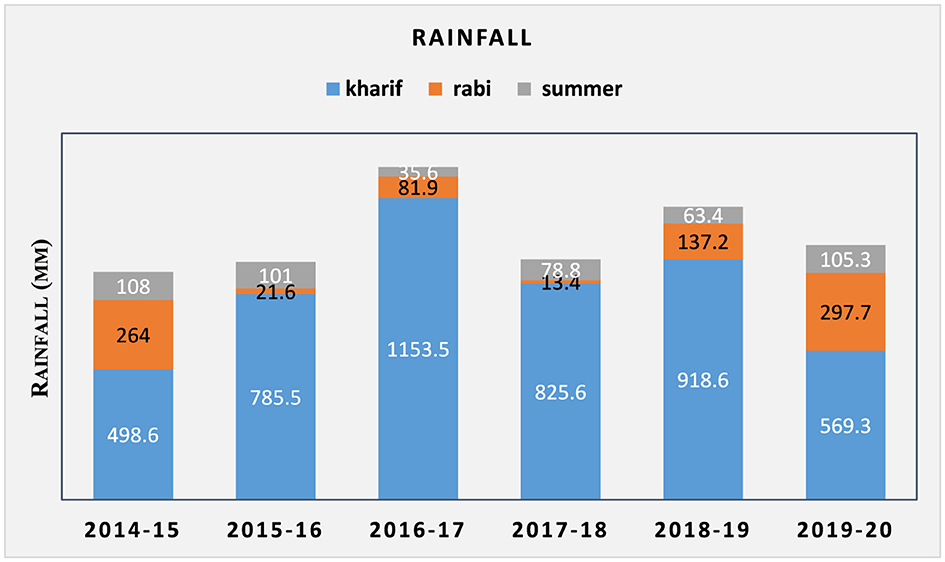
Figure 1. Weekly average temperature, evaporation and rainfall during study period in New Delhi during 2014–15 to 2019–20.
2.2 Treatment details and crop management
The triplicate on-station trials were executed in a split-plot design to evaluate moisture conservation and nutrient management systems (Table 1). The main plots were assigned to four moisture conservation treatments: no mulch (control; M1), crop-residue mulch (CRM) applied at 5 t/ha (M2), farmyard manure (FYM) applied at 5 t/ha (M3), and a combination of CRM and FYM, each at 2.5 t/ha (M4). Sub-plots were designated for three nutrient management practices: no fertilization (control; N1), the recommended dose of nitrogen (RDN; N2), and 50% RDN combined with biofertilizer Azospirillum + Pseudomonas striata (N3). The treatment plots measured 6 × 6 meters, with pearl millet (var. Pusa Composite-443) was sown at 0.45 × 0.15 m spacing with 4 kg/ha seeding rate, and Indian mustard (var. Pusa Tarak) was sown using 5 kg seed/ha with 0.45 × 0.30 m spacing, following standard agronomic practices. Mustard crop residues were used as the mulching material. The FYM with NPK compositions of 0.52%−0.54%, 0.26%−0.29%, and 0.5%−0.53%, respectively, was used in the study. Soil test-based nutrient application was made, providing 60 kg N/ha to both crops, with phosphorus (40 kg P2O5/ha) and potassium (40 kg K2O/ha) applied before sowing, and the remaining 20 kg N/ha was top-dressed at the tillering stage for pearl millet and the branching stage for mustard. To manage the weeds, atrazine 0.6 kg a.i./ha as pre-emergence was applied in pearl millet and a hand weeding was carried out after 3 weeks of sowing. In mustard, pendimethalin (1 kg a.i./ha) was applied as pre-emergence to minimize early weed competition. No irrigation was provided to any of the crop during the entire period of experimentation.
2.3 Yield measurement and sustainability assessment
Both the crops were harvested at maturity stage, leaving the border rows, a net area of 4.65 × 6 m was taken to measure the grain yield of pearl millet and seed yield of mustard at a moisture content of 12% w/w. Pearl millet was reaped manually during the first fortnight of October each crop year, while mustard was harvested in the second fortnight of March. Both crops were cut at a height of 4–5 cm above the soil surface. To facilitate a direct comparison between the yields of both crops, the mustard seed yields were converted to pearl millet equivalent yield (PEY) using the Equation 1.
Where, My represents the mustard seed yield (tons/ha), Pm is the price of mustard (₹/ton), and Ppm is the price of pearl millet (₹/ton), based on the Minimum Support Prices (MSP) declared by the Government of India for the 2020–21 crop year. System productivity was then calculated as the sum of the actual pearl millet yield and the PEY of mustard, as applicable to the treatments.
2.4 Sustainable yield index
The sustainability of pearl millet, mustard, and the overall pearl millet–mustard production system over the 6-year study period was obtained using the sustainable yield index (SYI), as proposed by Vittal et al. (2002). The SYI was calculated using the following equation:
Where, Yt is the mean yield for a particular treatment or system, σ is the standard deviation of the yield for that treatment, and Ymax is the maximum yield observed across all treatments and years. This index provides a measure of yield stability and sustainability, taking into account both the average performance and variability of yields over time.
2.5 Estimation of rainwater use efficiency
Rainwater use efficiency (RUE) was calculated to assess the efficiency with which the crops utilized the available rainfall during their growth period. The RUE (expressed in kg/ha-mm) was determined using Equation 3.
Where, Yg represents the grain yield (kg/ha) and r denotes the total rainfall (mm) received during the crop's growing period. This metric provides an important indicator of how effectively the crops converted rainfall into yield, which is critical for understanding water-use pattern in rainfed agricultural production systems.
2.6 Soil sampling and laboratory analysis
At the initiation and after the completion of the sixth cropping system cycle in the last week of April 2020, soil samples were collected from the 0–0.15 m soil profile using a core sampler with 0.075 m diameter. To minimize the border effects, sampling was conducted from the central rows of each plot. The soil from each core was thoroughly mixed to create a composite sample for each plot, from which a 0.25 kg subsample was taken for laboratory analysis. The samples were air-dried for 72 h and then passed through 2.0 mm sieve prior to analysis. The soil organic carbon (SOC) was determined using the Walkley and Black's (1934) method, which involves the wet oxidation of organic matter and titration to estimate the carbon content. The chloroform-fumigation extraction method was used to determine soil microbial biomass carbon (SMBC) and nitrogen (SMBN), with the results expressed as μg/g of dry soil (Vance et al., 1987).
Available nitrogen (N) in the soil samples was measured using the Kjeldahl method (Subbaiah and Asija, 1956). Plant-available soil phosphorus was extracted employing the Olsen (1954) method, using 0.5 M NaHCO3, with measurements taken via spectrophotometer. Available potassium (K) was determined using the ammonium acetate extraction method (Jackson, 1958).
The soil profile enzymatic activities of acid and alkaline phosphatases were quantified through 16 mM para-nitrophenyl phosphate as substrate, following the Tabatabai and Bremner (1969) methodology. Dehydrogenase activity of plow layer of soil was evaluated based on the reduction of triphenyltetrazolium chloride to triphenylformazan, as outlined by Rana et al. (2014). To estimate protease activity in the soil, the method described by Ladd and Butler (1972) was used, where casein was used as a substrate. The protease activity was expressed as μg of tyrosine released per gram of soil per hour.
2.7 Economic evaluation
An economic evaluation was carried out to determine the profitability of the treatments. The costs associated with all inputs and operations, including seed, crop residue, farmyard manure (FYM), tillage, fertilization, plant protection measures, harvesting, and threshing, were compiled for each treatment. The prevailing market prices of these inputs and operations were used to estimate the total cost of cultivation. Additionally, the costs of hiring tractor-driven machinery and wages for human labor (based on an 8-h workday) were included in the cost analysis. The minimum support prices (MSP) for pearl millet and mustard, as declared by the Government of India during 2020–21, were used to calculate the gross returns for each treatment. Further, the prevailing market prices of crop residues of pearl millet and mustard (83 and 35 USD/t, respectively) were used. Gross returns were determined following the methodology described by Das and Das (2018). Net returns were then calculated using the Equation 4:
All the net return values were converted into equivalent US dollars.
2.8 Data analysis
The data collected were analyzed using the analysis of variance (ANOVA) technique appropriate for split plot design, following the methodology outlined by Snedecor and Cochran (1989). The statistical analysis was performed using the PROC GLM procedure in the SAS 9.3 software package (SAS Institute, Cary, NC). Additionally, a pooled analysis of variance (two-factor analysis) was conducted on the 6-year data to evaluate the effects of treatments and the interaction between years and treatments on pearl millet grain yield, mustard seed yield, and the system productivity (Table 2). After completion of study, soil health parameters analysis was carried out and analysis of variance is presented as Table 3. The significance of the results was determined at the 5% level (P ≤ 0.05).
GGE-biplot analysis was conducted using the “GGE-biplot GUI” package in “RStudio,” version 2022.12.0 (Dia et al., 2016; RStudio Team, 2020). This analysis was employed to examine the relationships among various treatments, environments, and their interactions, to rank treatments based on stability and mean performance within each treatment, and to identify the best-performing combinations (Yan et al., 2000; Yan and Kang, 2002).
3 Results
3.1 Pearl millet productivity
The productivity of pearl millet across the treatments exhibited noteworthy variations, ranging from 0.93 to 3.39 t/ha (Table 4; Supplementary Figure 1). The mean pearl millet yield over the 6 years was highest in M4 (2.71 t/ha), followed by M3 (2.55 t/ha), while the lowest average yield (1.59 t/ha) was observed in M1 (Table 4). Notably, N2 produced higher yields than N1 in most years. In the latter 3 years of the study, N3 treatments showed significant improvements in yield, with an increase of 21.5% over the control. The combined application of CRM and FYM was particularly effective in maintaining high yields, surpassing yields from either CRM or FYM alone by 9.15% and 12.82%, respectively. During the initial 3 years of the experiment, treatments focusing on CRM performed better, with M2 consistently yielding more than M3. However, in the latter half of the study period, M3 surpassed M2 (Supplementary Figure 1).
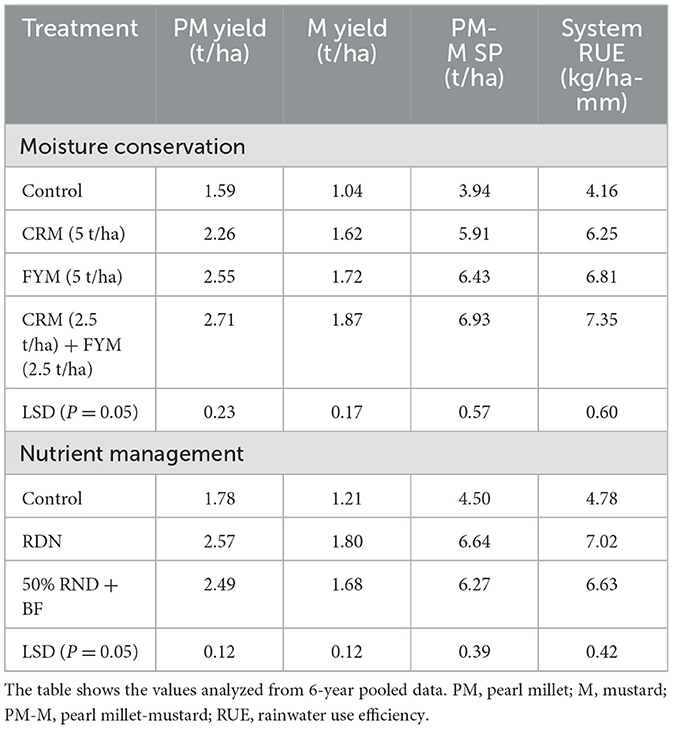
Table 4. Effect of moisture conservation and nutrient management strategies on productivity and rainwater use efficiency of pearl millet-mustard cropping system.
The M4N3 and M4N2 treatment amalgamations demonstrated the greater pearl millet yields, averaging 2.97 t/ha and 2.96 t/ha, respectively (Figure 2). The highest pearl millet yield was observed in M4N3, reaching 3.39 t/ha, followed by M4N2 (3.32 t/ha) during 2019–20. On the lower end of the spectrum, treatment combinations like M1N1 (0.93 t/ha) during 2017–18, M1N3 (1.34 t/ha) during 2018–19 and M2N1 (1.44 t/ha) during 2016–17 performed poorly. These treatments not only produced lower average yields but also showed greater year-to-year yield variability. Yield variability was also influenced by annual rainfall. In 2016–17, the year with the highest rainfall (1271 mm), yields peaked across most treatments, particularly in M4N2 and M3N2, where yields reached 3.04 t/ha and 2.76 t/ha, respectively (Supplementary Figure 1). Conversely, in 2015–16, a relatively dry year with relatively low and unequal distribution (908.1) mm of rainfall, yields dropped significantly, particularly in treatments lacking moisture conservation measures.
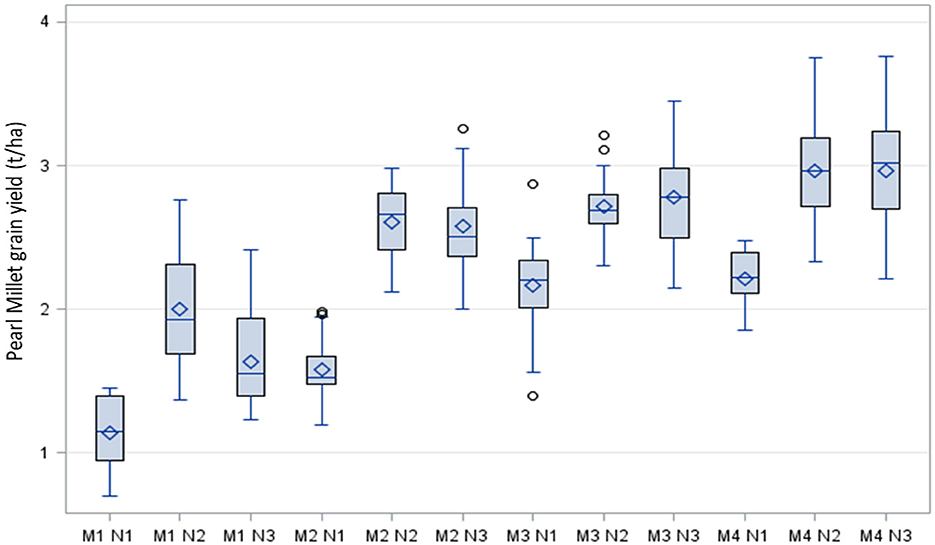
Figure 2. Effect of integrated moisture conservation and nutrient management practices on pearl millet grain yield.
The highest SYI values were recorded in M4N1 (0.92) followed by M2N1, M2N2 and M3N2 (0.88), illustrating that these treatments provided the most stable and sustainable pearl millet yields over the six-year study period. Conversely, treatments such as M1N3 (0.61), M1N2 (0.63), and M1N1 (0.73) had much lower SYI values, indicating that they were more prone to yield declines under adverse scenarios, highlighting the importance of moisture conservation in rainfed systems.
3.2 Mustard productivity
Mustard productivity exhibited notable variability across years and treatments, ranging from 0.45 to 2.69 t/ha (Figure 3). The treatments which integrated higher nutrient inputs (N2 and N3) along with moisture conservation practices (M3 and M4) consistently outperformed the lower input treatments (Table 4). The M4N2 and M4N3 treatment nexus achieved the highest average yields, with 2.09 t/ha and 2.07 t/ha, respectively (Figure 4; Supplementary Figure 3). These treatments involved CRM coupled with either high nutrient rates or biofertilizer co-application, which significantly contributed to their superior performance. The peak mustard yield was observed in M4N2 during the 2019–20 season, reaching 2.68 t/ha, emphasizing the combined benefits of effective moisture conservation and nutrient management. In contrast, treatments with minimal moisture conservation practices and lower nutrient levels, such as M1N1 (0.76 t/ha) and M1N3 (1.06 t/ha), yielded significantly less (Supplementary Figure 2).
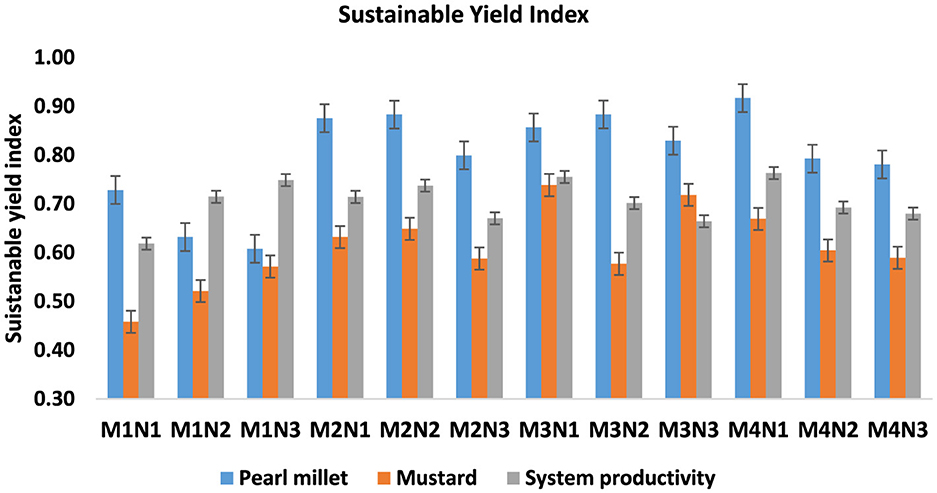
Figure 3. Effect of integrated moisture conservation and nutrient management practices on sustainable index of pearl millet grain yield, mustard seed yield, and pearl millet-mustard system productivity.
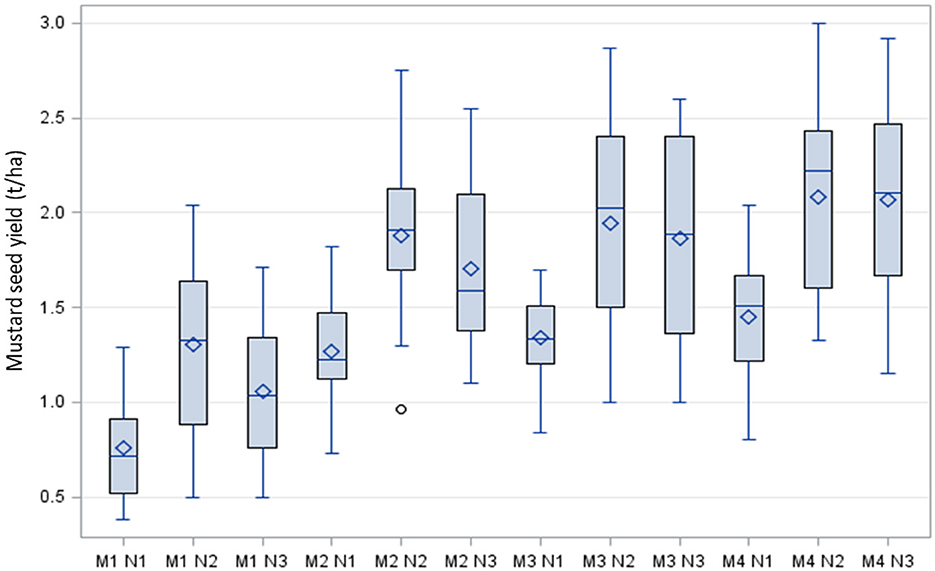
Figure 4. Effect of integrated moisture conservation and nutrient management practices on mustard seed yield.
Temporal fluctuations in productivity were closely linked to seasonal rainfall variations (Supplementary Figure 2). For example, 2016–17, which received the highest rainfall (1,271 mm), witnessed generally higher yields across treatments, with M2N2 and M3N2 recording yields of 1.97 t/ha and 1.83 t/ha, respectively. In contrast, the 2015–16 season, characterized by lower rainfall (908.1 mm), resulted in extremely reduced mustard yields, particularly in treatments without mulching, such as M1N1 (0.53 t/ha) and M2N1 (0.95 t/ha).
The SYI further emphasized the long-term stability of these treatments. Treatments such as M3N1 (0.74) and M4N1 (0.67), demonstrated the highest sustainability, maintaining reliable productivity over the six-year study period despite environmental variability (Figure 3). Conversely, treatments like M1N1 (0.46) and M1N2 (0.52) exhibited lower SYI values, highlighting their sensitivity to yearly fluctuations and environmental stress, leading to less stable productivity over time.
In general, the treatments with higher nutrient doses and improved moisture conservation (M3 and M4) consistently outperformed the lower input treatments (M1 and M2). Among nutrient treatments, N2 outperformed N1 and N3 in most years, indicating that an optimal balance of nutrient inputs and moisture conservation significantly boosts mustard productivity. The overall mean productivity for the 6-year period was highest in M4 (1.87 t/ha), followed by M3 (1.72 t/ha), with the lowest mean yield observed in M1 (1.04 t/ha).
The combined application of CRM and FYM consistently resulted in highest seed yield, outperforming CRM or FYM alone by 8.4% and 14.3%, respectively. In the initial 3 years of the study, M2 (which relied on CRM) led to higher mustard yields compared to M3 (which involved FYM). However, in the later 3 years, M3 surpassed M2, mirroring a trend also observed in pearl millet productivity (Figure 4). Such trend suggests that while CRM offers immediate moisture conservation benefits, FYM contributes to sustained productivity improvements in the long-run. In terms of nutrient management, N2 consistently produced the greater yields during the first 3 years of the experiment.
3.3 Pearl millet-mustard system productivity
The blend of M4N2 treatment steadily yielded the highest system productivity, with a 6-year mean of 7.67 t/ha, followed closely by M4N3 with a mean of 7.64 t/ha (Figure 5). These two treatment combinations achieved the greatest system productivity in the last year of the study, 2019–20, where yields reached 9.38 t/ha in M4N2 and 9.47 t/ha in M4N3 (Supplementary Figure 4). The M4 moisture conservation practice, involving CRM, consistently enhanced system productivity. It outperformed other moisture conservation practices, producing 13.3% higher yields than M2, 12.3% higher than M3, and 41.4% higher than M1. Interestingly, while M2 initially outperformed M3 in system productivity during the first 3 years, a trend reversal occurred from the 4th year onward, with M3 surpassing M2. This suggests that while M2 provided early yield benefits, M3 showed cumulative temporal benefits, particularly as soil moisture retention and organic matter improved in subsequent years (Supplementary Figure 4).
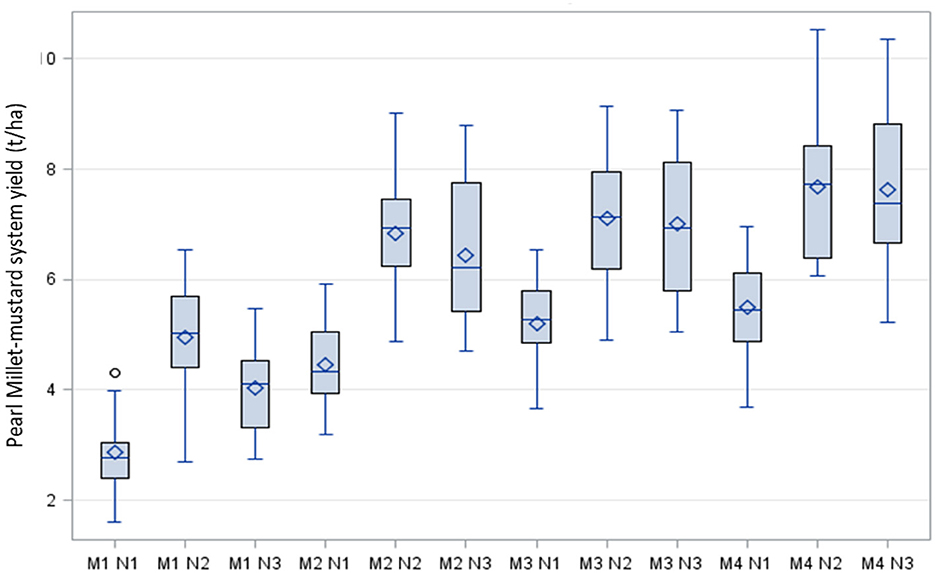
Figure 5. Effect of integrated moisture conservation and nutrient management practices on pearl millet-mustard system productivity.
In terms of nutrient management, treatments involving higher nutrient inputs outperformed the control (N1). Both N2 and N3 treatments resulted in significantly higher system productivity, with yields increasing by 35% over the control (Table 3). Although N2 produced higher productivity than N3 during the first 3 years, the trend reversed in the subsequent years of the study, with N3 (which included biofertilizer application) showing superior performance, highlighting the long-term benefits of biofertilizers in maintaining system productivity. The SYI further demonstrated the sustainability of treatment combinations like M4N1, M3N1, M1N3, and M2N2 showing the highest SYI values (0.76, 0.76, 0.75, and 0.74, respectively).
3.4 GGE-biplot analysis for pearl millet, mustard and system productivity
3.4.1 Which-won-where
The “Which-Won-Where” view of the GGE-biplot analysis revealed that the M4N3 treatment consistently outperformed other treatments in pearl millet (Figure 6A) and mustard yield (Figure 6C) and system productivity (Figure 6E), with M4N2 closely following. The first principal component (PC1) explained 95.03% of the variation, while the second principal component (PC2) accounted for an additional 3.78%, together capturing 98.81% of the total variation in yield across treatments for both crops. The GGE-biplot categorized the experimental treatments into six distinct sectors based on their variability.
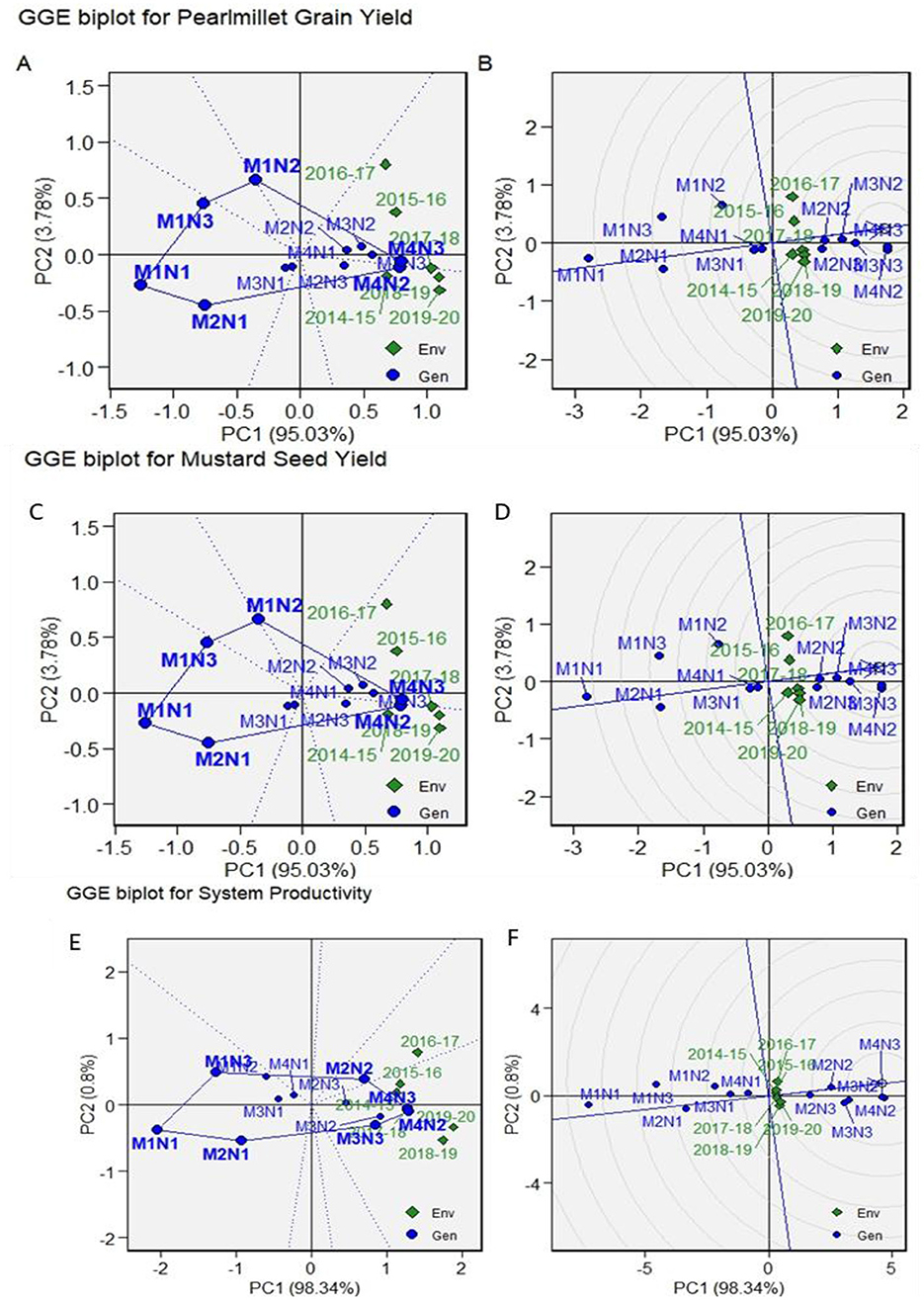
Figure 6. GGE biplots for pearl millet grain yield, mustard seed yield and pearl millet-mustard system productivity. (A) “Which-won-where” view of pearl millet yield; (B) “ranking treatments” view of pearl millet yield; (C) “which-won-where” view of mustard yield; (D) “ranking treatments” view of mustard yield; (E) “which-won-where” view of system productivity; (F) “ranking treatments” view of system productivity.
For the overall pearl millet-mustard system productivity, PC1 and PC2 explained 98.34% and 0.80% of the variation, respectively, accounting for a total of 99.14% (Figure 6F). Based on system productivity, the GGE-biplot further divided the treatments into seven distinct sectors. Interestingly, environmental factors were grouped into only two sectors, indicating limited environmental variability throughout the study period (2014–15 to 2019–20).
The treatments at the vertices of the polygon in the biplot were identified as the most responsive, with the vertex treatment being optimal for the environments within their respective sectors. Among these, M4N3 and M4N2 were the top performers across multiple environments. M4N3 performed optimal in years 2015–16 and 2016–17, while M4N2 in 2014–15, 2018–19, and 2019–20. Both treatments performed similarly during the 2017–18 season. Conversely, M1N1 and M1N3 were identified as the poorest performers across the study period.
3.4.2 Ranking treatments
The GGE-biplot for ranking treatments showed that M4N3 was closest to the center of the innermost circle, making it the highest-ranked treatment overall. This suggests that M4N3 is the most effective treatment for achieving the highest system productivity. The ranking of treatments was in similar order for pearl millet yield (Figure 6B), mustard yield (Figure 6D), and pearl millet-mustard system yield (Figure 6F). The ranking of the treatments, according to the GGE-biplot, was as follows: M4N3 > M4N2 > M3N3 > M3N2 > M2N2 > M2N3 > M4N1 > M3N1 > M1N2 > M2N1 > M1N3 > M1N1. Presence of later three years toward the inner orbit highlights that the organic integration provides benefits after 2–3 years of constant organic use.
3.5 Pearl millet-mustard system economics
The net returns from pearl millet ranged from USD 359.8 in M1N1 to USD 980.6 in M3N2, highlighting the significant impact of improved moisture conservation and nutrient inputs on the crop's profitability (Figure 7). Treatments with higher inputs (M2, M3, and M4) consistently resulted in greater net returns compared to the control (M1). Among all treatments, M3N2 achieved the highest net returns from pearl millet, outperforming the control treatment M1N1 by 172.6%, indicating the substantial benefits of strategically combining efficient moisture conservation (M3) with optimal nutrient management (N2).
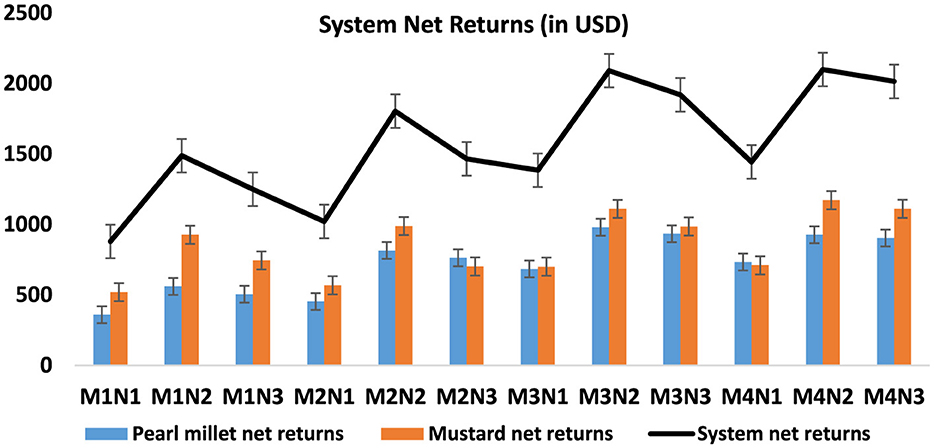
Figure 7. Effect of integrated moisture conservation and nutrient management practices on economics of pearl millet-mustard system productivity.
The net returns from mustard also exhibited a similar pattern, with values ranging from USD 519.9 in M1N1 to USD 1,172.7 in M4N2. The highest net returns from mustard were observed in M4N2, which incorporated CRM with higher nutrient inputs, demonstrating the economic advantage of integrated moisture and nutrient management. The M3N2 also performed well, with net returns of USD 1,110.6. Lower-input treatments, such as M1N1 and M2N1, yielded relatively lower returns.
The system net returns ranged from USD 879.7 in M1N1 to USD 2,099.6 in M4N2, highlighting the economic superiority of the M4N2 treatment. This treatment, which incorporated CRM with higher nutrient levels (N2), delivered the highest overall profitability, yielding 138.6% higher returns compared to the control (M1N1). In addition, M3N2 and M4N3 treatments also produced substantial system net returns, reaching USD 2,091.2 and USD 2,015.0, respectively. Overall, treatments with higher moisture conservation (M3 and M4) and optimal nutrient inputs (N2 and N3) consistently outperformed than those with lower inputs (M1 and M2). The M4 treatments (particularly M4N2) steadily delivered the highest net returns across both individual crops and the entire system. This highlights the economic viability of integrated moisture conservation and nutrient management practices, especially in semi-arid environments.
3.6 Rainwater use efficiency of pearl millet-mustard system
The RUE values of the pearl millet–mustard system ranged widely between treatments, from 1.69 kg/ha-mm in M1N1 during 2016–17, to a high of 9.75 kg/ha-mm in M4N3 during 2019–20 (Figure 8). Across all treatments, M4N2 consistently exhibited the highest average RUE, with values peaking at 9.66 kg/ha-mm in the final year (2019–20), reflecting the effectiveness of integrating advanced moisture conservation with balanced nutrient management. Similarly, treatments involving M4 and M3 moisture conservation practices generally demonstrated higher RUE compared to the M1 and M2 treatments (Table 4).
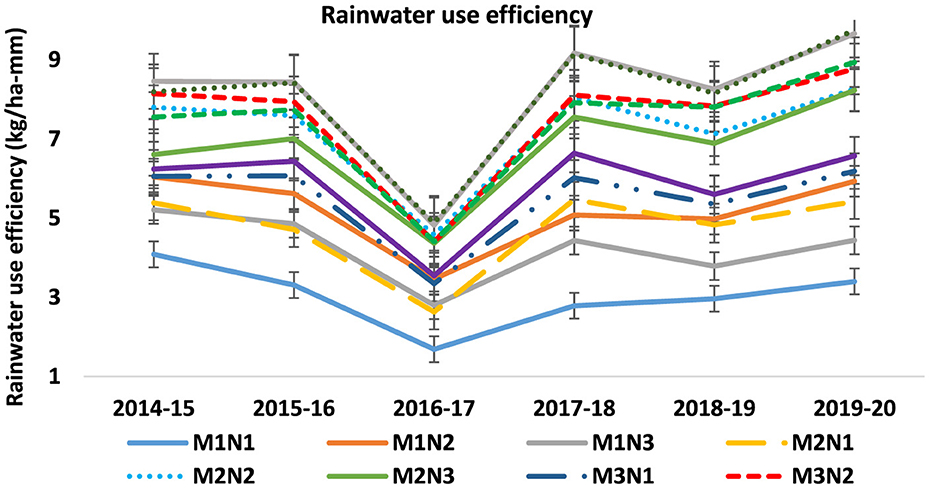
Figure 8. Effect of integrated moisture conservation and nutrient management practices on rainwater use efficiency.
M4 treatments (M4N1, M4N2, and M4N3) consistently achieved the highest RUE values, with M4N3 recording the highest RUE (9.75 kg/ha-mm) in 2019–20. This can be attributed to effective moisture conservation practices coupled with sufficient nutrient application. M3 treatments also showed high RUE, with M3N2 and M3N3 attaining maximum values of 8.77 and 8.94 kg/ha-mm, respectively, in 2019–20. The M1 treatments, which received the lowest levels of moisture conservation inputs, had the lowest RUE values across the study period, particularly M1N1, with an average of 2.79 kg/ha-mm in 2017–18. These treatments had the least rainwater use efficiency, likely due to the absence of mulching and minimal nutrient application. Nutrient management significantly influenced RUE, particularly in the higher-input treatments (N2 and N3). The data reveals that N2 treatments generally resulted in higher RUE than N3 treatments (biofertilizer) in the early years of the experiment, but the trend reversed during the final 2 years (2018–19 and 2019–20), where N3 recorded higher RUE in both M3N3 and M4N3 treatments.
RUE varied significantly across the years, largely due to fluctuating rainfall. The lowest average RUE (3.74 kg/ha-mm) observed in 2016–17, which saw the highest rainfall (1,271 mm), suggesting reduced efficiency with excess water. In contrast, 2019–20, with moderate rainfall of around 970 mm, recorded the highest RUE (7.13 kg/ha-mm), highlighting the benefits of optimal moisture during moderate rainfall conditions.
3.6.1 GGE-biplot analysis for rainwater use efficiency
3.6.1.1 Which-won-where
The “Which-Won-Where” view of the GGE-biplot analysis highlighted the M4N3 treatment as the top performer in terms of RUE, with M4N2 closely following (Figure 9A). The PC1 explained 98.46% of the variation, while the PC2 accounted for 0.63%, collectively capturing 99.09% of the variability in RUE across treatments. The GGE-biplot divided the treatments into seven distinct sectors based on variability in their rainfall use efficiency. M4N2 and M4N3 were constantly the best-performing treatments, while M1N1 and M1N3 exhibited the poorest performance throughout the investigation. M4N2 and M4N3 were positioned together in the same sector, reflecting their similar efficiency. M4N3 and M4N2 steadily demonstrated superior RUE during the 2014–15 to 2017–18. However, in the last 2 years of the study (2018–19 and 2019–20), M2N3 emerged as the top treatment for RUE.
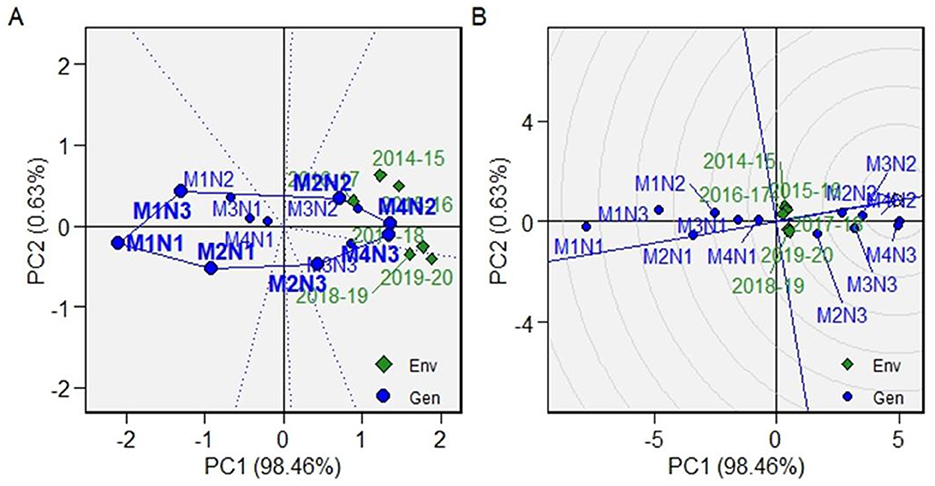
Figure 9. GGE biplot for rainwater use efficiency (RUE). (A) “Which-won-where” view of RUE; (B) “ranking treatments” view of RUE.
3.6.1.2 Ranking treatments
The GGE-biplot ranking analysis identified M4N2 as the top treatment for RUE, being closest to the center of the innermost circle (Figure 9B). M4N3 followed closely as the second-best treatment, with nearly identical performance to M4N2. The ranking of treatments based on the GGE-biplot analysis was as follows: M4N2 > M4N3 > M3N3 > M3N2 > M2N2 > M2N3 > M4N1 > M3N1 > M1N2 > M2N1 > M1N3 > M1N1.
3.7 Soil organic carbon and nutrient content
Significant improvements in soil health parameters—available N, P, K (Figure 10), and SOC% (Figure 11)—under various moisture conservation and nutrient management treatments. SOC% increased across all treatments, reaching its highest level of 0.48% in the M4N2 treatment, while the moisture conservation practices also maintained elevated SOC levels, with M4 showing 0.43%. The available N content, initially at 175.3 kg/ha, varied widely, with M4N2 recording the highest value at 220.1 kg/ha. Treatments M4 and M2 also exhibited substantial N retention, reaching 198.8 kg/ha and 193.6 kg/ha, respectively. Available P levels increased from the initial 12.8 kg/ha, peaking at 16.3 kg/ha in M4N2, with M4 demonstrating the highest P retention among moisture conservation treatments. Available K levels rose significantly from the initial value of 178 kg/ha, with M2N2 achieving the highest K content at 284.3 kg/ha. Overall, both moisture conservation and nutrient management practices enhanced soil chemical health, with treatments M4 and N2 showing the most notable improvements across all parameters.
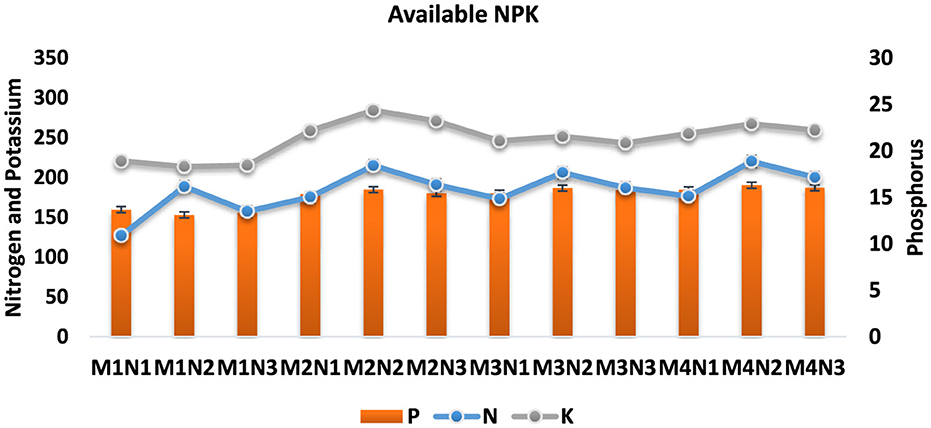
Figure 10. Effect of integrated moisture conservation and nutrient management practices on available nitrogen (N), phosphorous (P), and potassium (K) content of soil.
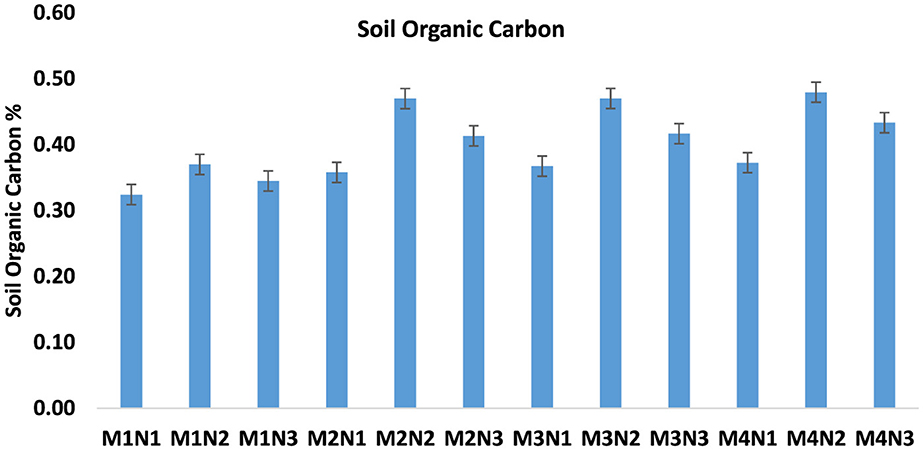
Figure 11. Effect of integrated moisture conservation and nutrient management practices on soil organic carbon.
3.8 Soil microbial enzymatic activity
The M4N3 treatment recorded the highest enzymatic activities across all parameters, including alkaline phosphatase (181 μmol p-nitrophenol/g/h), acid phosphatase (86.30 μmol p-nitrophenol/g/h), dehydrogenase (59.30 μg TPF/g/24 h), and protease (45 μmol p-nitrophenol/g/h) (Figure 12). The M4 treatment (CRM + FYM) showed the highest average enzymatic activities, while the M1 had the lowest. Among nutrient treatments, N2 had the highest alkaline and acid phosphatase activities, while N3 showed higher protease activity. Overall, the integration of moisture management with biofertilizers-embedded nutrition (M4N3) significantly enhanced soil enzymatic activities, indicating improved soil microbial health and nutrient cycling.
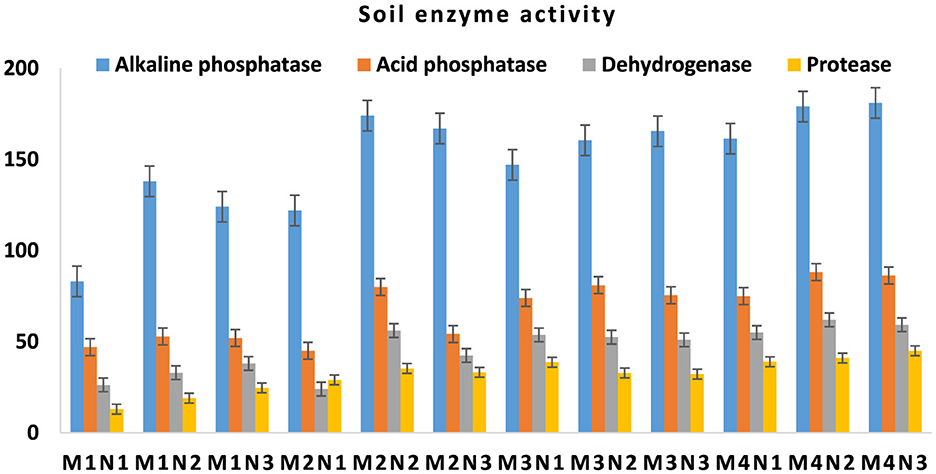
Figure 12. Effect of integrated moisture conservation and nutrient management practices on soil enzymatic activity.
The SMBC values ranged from 141 μg/g in M1N1 to 245 μg/g in M4N3 (Figure 13). Treatments with higher levels of moisture conservation and nutrient inputs (M4N2 and M4N3) exhibited substantially higher SMBC values. M4N2 showed an SMBC of 236 μg/g, whereas the lower-input treatments such as M1N1 (141 μg/g) and M1N3 (153 μg/g) exhibited the lowest microbial biomass carbon, indicating that improved resource management significantly boosted microbial biomass. SMBN followed a similar trend, with the lowest value observed in M1N1 (12.4 μg/g) and the highest values recorded in M4N2 (29 μg/g) and M4N3 (28 μg/g). Treatments with medium to high inputs like M2N2 (29 μg/g) and M3N2 (27.7 μg/g) also showed elevated SMBN compared to the low-input treatments. The higher SMBC: SOC ratio observed in treatments like M4N3 (56.5) and M4N2 (49.6). In contrast, M3N2 exhibited the lowest ratio (38.6), suggesting lower microbial carbon efficiency in this treatment. The ratio of SMBC to SMBN, varied from 6.5 in M3N2 to 11.6 in M1N1. Treatments with higher nutrient inputs and moisture conservation, such as M2N2 (6.66), M3N2 (6.53), and M4N2 (8.14), lower SMBC ratios.
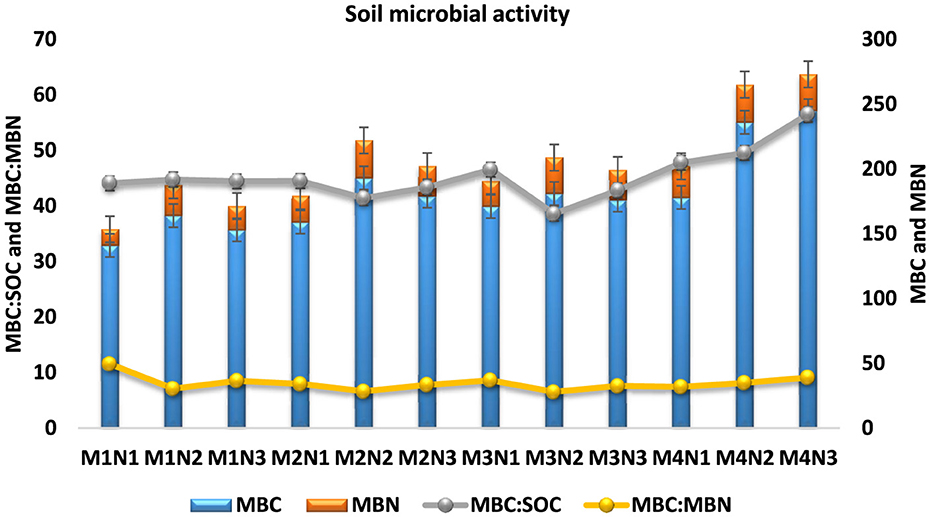
Figure 13. Effect of integrated moisture conservation and nutrient management practices on soil microbial activity.
4 Discussion
4.1 Moisture conservation practices
The integration of crop-residue mulch (CRM) with farmyard manure (FYM) emerged as the most effective technique, delivering superior grain yield of pearl millet (2.71 t/ha) and mustard (1.87 t/ha), as well as enhanced system productivity (6.93 t/ha) compared to other treatments. Such results suggest that the gradual decomposition of CRM, coupled with the nutrient-rich FYM contributed to improvement in soil properties, nutrient availability, better root proliferation, and crop growth, in addition to their moisture conservation advantages (Hazra et al., 2018; Rajanna et al., 2022). Further, combined use of CRM and FYM resulted in more stable yields while reducing year-to-year yield variability, mainly owing to temporal soil fertility build-up (Figures 10–12) relative to other treatments, in addition to thermal moderation effects of residue retention under CRM treatments (Bamboriya et al., 2017; Bana et al., 2020).
Moreover, the conjunctive CRM and FYM usage cuts down the overall cost of cultivation. The consequent cost-efficiency obtained from co-application translated into higher net monetary returns, particularly for mustard, which gained twin benefits of higher yields and lucrative market prices. These findings underscore the economic viability of adopting integrated moisture conservation and nutrient management strategies to enhance farm profitability, which is crucial in rainfed and resource-constrained agricultural systems (Bamboriya et al., 2017).
Sustainability, reflected in the sustainable yield indices (SYI), was also significantly greater under the joint application of CRM (2.5 t/ha) + FYM (2.5 t/ha), indicating the pivotal roles played by organic inputs in ensuring yield stability, moisture retention and soil health over time (Susha et al., 2018; Behera et al., 2019). The improved sustainability is likely due to the balanced and gradual nutrient release provided by the organics, which enhanced nutrient status and reduced moisture depletion in plow layer of the soil.
Rainwater use efficiency (RUE) was another critical parameter affected by moisture conservation options. The CRM (2.5 t/ha) + FYM (2.5 t/ha) conjunctive use showed a 12% improvement in RUE compared to CRM (5 t/ha) or FYM (5 t/ha) alone, and a substantial 41% increase over the control. This enhancement in RUE is likely due to the mulch layer, which reduced evaporation losses and retained soil moisture, providing a more conducive rhizospheric environment, as evidenced by similar findings in other studies (Chauhan and Opeña, 2012; Bana et al., 2018, 2023b).
The highest available N, P and K in the soil was recorded under the co-use of CRM + FYM. This enhanced nutrient availability in soils is associated with the improved soil organic carbon (SOC) content, which was 14% higher compared to CRM (5 t/ha) or FYM (5 t/ha) alone, and 70% higher than the control. This escalation in SOC is likely the result of the stimulated microbial activity, which plays a critical role in organic matter decomposition and nutrient mineralization, thereby enhancing nutrient availability for plant uptake (Gupta et al., 2007; Bhattacharyya et al., 2015; Jones et al., 2018). Furthermore, moisture conservation practices significantly improved SMBC and SMBN. For instance, M4N3 recorded the highest SMBC and SMBN, while M1N1 had the lowest values. The higher SMBC: SMBN ratio in M4 treatments indicates better microbial utilization of SOC under improved moisture scenarios. These findings confirm that moisture availability is crucial for enhancing microbial activity and soil fertility, particularly in dry environments (Tiemann and Billings, 2011; Bian et al., 2022).
4.2 Nutrient management
Nutrient management practices were equally critical in influencing the productivity, economics, and sustainability of the pearl millet—mustard cropping system. The treatment combining 50% of the recommended dose of nitrogen (RDN) with biofertilizer (BF) emerged as a highly cost-effective strategy. This approach reduced input costs while maintaining high yields and system sustainability, making it an attractive option for farmers operating in resource-constrained environments. The yields achieved under the 50% RDN + BF treatment was comparable to those produced with the full RDN, demonstrating that integrating biofertilizers can partially substitute for synthetic fertilizers without compromising productivity (Bana and Gautam, 2009; Kumar et al., 2019).
From an economic perspective, the 50% RDN + BF treatment generated higher net returns than the full RDN or control treatments. This result can be attributed to the lower input costs associated with biofertilizers, as well as the high yields sustained under reduced nitrogen input levels. Similar findings have been reported in other studies, where biofertilizers were shown to effectively enhance nutrient use efficiency and reduce the dependency on chemical inputs (Kumar et al., 2019; Choudhary et al., 2021).
In the similar manner, the available NPK under 50% RDN + BF treatment was comparable to that of the full RDN treatment, and both significantly outperformed the control. This finding reinforces the potential of biofertilizers to maintain nutrient availability while reducing synthetic nitrogen inputs. The increase in SOC content, which was 49% higher than the control, further supports the idea that these nutrient management practices not only improve short-term productivity but also contribute to long-term soil health and sustainability (Bhattacharyya et al., 2015).
4.3 Interaction between moisture conservation and nutrient management
The synergistic interactions were evident in both the yield outcomes and resource-use efficiencies, where the combination of CRM and FYM with 50% of the RDN supplemented with BF consistently outperformed other treatment combinations. The improved productivity under this integrated approach can be attributed to multiple factors. Firstly, the application of CRM helped conserve soil moisture by reducing surface evaporation and improving water infiltration, while FYM contributed to organic matter accumulation, improving soil structure and water-holding capacity (Choudhary et al., 2014). These benefits were amplified when combined with reduced synthetic nitrogen inputs and biofertilizers, which stimulated microbial activity and enhanced nutrient cycling, resulting in greater nitrogen availability and uptake by crops (Bhattacharyya et al., 2015). This synergy between moisture conservation and nutrient management not only ensured optimal crop growth environment throughout the life-cycle but also contributed to the long-term system sustainability by reducing input dependency while maintaining high productivity (Sepat et al., 2019).
The positive interaction between CRM + FYM and 50% RDN + BF was particularly evident in the SYI, where this combination maintained higher SYI values compared to other treatments, indicating greater yield stability across years despite variability in rainfall and other environmental factors. This suggests that moisture conservation practices buffer the system against climatic variability, while nutrient management ensures sufficient nutrient supply to support crop growth under such conditions (Susha et al., 2018; Kaur et al., 2020). Moreover, the enhanced available soil nutrients (NPK) observed in the combined treatment further reinforces the importance of an integrated approach, as the microbial activity stimulated by biofertilizers and organic inputs likely contributed to improved nitrogen mineralization and uptake efficiency (Jones et al., 2018). Treatments M4N2 and M4N3 exhibited the highest SMBC and SMBN values. These treatments also showed moderate SMBC: SMBN ratios and higher SMBC: SOC ratios, indicating improved microbial activity and soil health (Bougnom and Insam, 2009). This synergy improves nutrient cycling and promotes sustainability in cropping systems, particularly in semi-arid environments. The results highlight the need for combined moisture and nutrient management to optimize soil fertility and crop productivity (Bana et al., 2024).
In terms of economic viability, the combined approach offered higher net monetary returns compared to individual treatments. The cost savings associated with reduced nitrogen input, coupled with enhanced yields and the attractive market price of mustard, resulted in greater profitability. This economic benefit emphasizes the potential of integrating organic amendments and biofertilizers with moisture conservation techniques in resource-constrained rainfed systems (Hazra et al., 2018). Additionally, the improved RUE under the CRM + FYM and 50% RDN + BF treatment indicates a more efficient use of available water, which is a critical factor for the sustainability of rainfed agriculture, particularly in semi-arid regions (Meena et al., 2009; Chauhan and Opeña, 2012).
The interaction effects also highlighted the long-term benefits of soil health improvements. The combined treatment enhanced SOC levels and microbial biomass, suggesting that the organic inputs promoted soil biological activity, which is key for maintaining soil fertility over time. Higher SOC content supports better soil structure, which in turn enhances water retention, nutrient availability, and root development (Bana and Gautam, 2009; Bana et al., 2024). This improvement in soil health further strengthens the sustainability of the pearl millet—mustard cropping system, as healthier soils are more resilient to environmental stressors and can sustain higher productivity with fewer external inputs (Behera et al., 2019). The RDN treatment combinations remained superior during initial years in terms of yield and RUE but during latter half of study period the trend reversed, where BF combinations recorded higher yield and RUE in both M3N3 and M4N3 treatments. This suggests that while the impact of chemical fertilizers is immediate, biofertilizers-embedded nutrient management may provide long-term benefits by improving soil health and water retention capacity of the soil over a period of time, ultimately enhancing productivity, yield stability and RUE in long-run.
5 Conclusion
This long-term study highlights that integrating moisture conservation systems with strategic nutrient management significantly improves the productivity, sustainability, and resource use efficiency of the pearl millet-mustard cropping system in the rainfed environments. The combination of crop-residue mulch (2.5 t/ha) with farmyard manure (2.5 t/ha) and half the recommended nitrogen dose supplemented with biofertilizers (Azospirillum + Pseudomonas striata) consistently outperformed other treatments in yield, sustainable yield index, and rainwater use efficiency, specifically, M4 and M3 moisture conservation treatments with N3 nutrition increased system productivity and rainwater-use efficiency (RUE) by >35%, compared to control. This integrated approach enhanced soil organic carbon, microbial activity, and available soil nutrients, while also reducing input costs, making it both effective and economically viable. The study has several limitations as well, viz., the findings are site-specific, limited to a single cropping system, and impacts are on single soil type. Variability in biofertilizer performance, economic viability, climatic fluctuations, and adoption challenges by farmers were not fully addressed, requiring further multi-soil, multi-location, multiple cropping systems research. The future work on similar lines may focus on studying adaptability of strategic co-application of moisture and nutrient management options under diverse climate change scenarios. Further, simulation modeling scenario analysis on investigating resilience of diverse options under various representative concentration pathways, including temporal rainfall and thermal extremities.
Data availability statement
The datasets presented in this study can be found in online repositories. The names of the repository/repositories and accession number(s) can be found in the article/Supplementary material.
Author contributions
SM: Conceptualization, Investigation, Writing – original draft, Writing – review & editing, Funding acquisition, Project administration, Resources, Validation, Visualization. RB: Conceptualization, Formal analysis, Investigation, Writing – original draft, Writing – review & editing, Data curation, Methodology, Supervision. RK: Investigation, Resources, Validation, Visualization, Writing – original draft. RN: Formal analysis, Writing – review & editing, Data curation, Writing – original draft. DS: Data curation, Formal analysis, Software, Writing – original draft. SG: Data curation, Methodology, Software, Writing – original draft. TS: Formal analysis, Funding acquisition, Project administration, Resources, Validation, Visualization, Writing – review & editing. AD: Formal analysis, Project administration, Resources, Visualization, Writing – original draft. TJ: Data curation, Software, Writing – review & editing. RS: Formal analysis, Software, Writing – original draft.
Funding
The author(s) declare that no financial support was received for the research and/or publication of this article.
Acknowledgments
The authors acknowledge the ICAR-Indian Agricultural Research Institute for providing resources and necessary facilities to carry out the research.
Conflict of interest
The authors declare that the research was conducted in the absence of any commercial or financial relationships that could be construed as a potential conflict of interest.
Generative AI statement
The author(s) declare that no Gen AI was used in the creation of this manuscript.
Publisher's note
All claims expressed in this article are solely those of the authors and do not necessarily represent those of their affiliated organizations, or those of the publisher, the editors and the reviewers. Any product that may be evaluated in this article, or claim that may be made by its manufacturer, is not guaranteed or endorsed by the publisher.
Supplementary material
The Supplementary Material for this article can be found online at: https://www.frontiersin.org/articles/10.3389/fsufs.2025.1597025/full#supplementary-material
References
Allohverdi, T., Mohanty, A. K., Roy, P., and Misra, M. (2021). A review on current status of biochar uses in agriculture. Molecules 26, 55–84. doi: 10.3390/molecules26185584
Anonymous (2024). Ministry of Agriculture and Farmers Welfare, Government of India. Available online at: https://pib.gov.in/PressReleasePage.aspx?PRID=2058534# (accessed December 5, 2024).
Bamboriya, S. D., Bana, R. S., Rana, K. S., and Choudhary, S. K. (2017). Effect of moisture conservation practices and integrated nutrient management on productivity, profitability, and energetics of rainfed pearl millet (Pennisetum glaucum) + clusterbean (Cyamopsis tetragonoloba) intercropping system. Indian J. Agron. 62, 1–6.
Bana, R. S., Choudhary, A. K., Nirmal, R. C., Kuri, B. R., Sangwan, S., Godara, S., et al. (2024). High-value crops' embedded groundnut-based production systems vis-à-vis system-mode integrated nutrient management: long-term impacts on system productivity, system profitability, and soil bio-fertility indicators in semi-arid climate. Front. Plant Sci. 14:1298946. doi: 10.3389/fpls.2023.1298946
Bana, R. S., Faiz, M. A., Sangwan, S., Choudhary, A. K., Bamboriya, S. D., Godara, S., et al. (2023a). Triple-zero tillage and system intensification lead to enhanced productivity, micronutrient biofortification and moisture-stress tolerance ability in chickpea in a pearlmillet-chickpea cropping system of semi-arid climate. Sci. Rep. 13:10226. doi: 10.1038/s41598-023-36044-0
Bana, R. S., and Gautam, R. C. (2009). Nutrient management through organic sources in pearlmillet (Pennisetum glaucum)–wheat (Triticum aestivum) cropping system. Int. J. Tropical Agric. 27, 127–129.
Bana, R. S., Grover, M., Singh, D., Bamboriya, S. D., Godara, S., Kumar, M., et al. (2023b). Enhanced pearl millet yield stability, water use efficiency and soil microbial activity using superabsorbent polymers and crop residue recycling across diverse ecologies. Eur. J. Agron. 148:126876. doi: 10.1016/j.eja.2023.126876
Bana, R. S., Sepat, S., Rana, K. S., Pooniya, V., and Choudhary, A. K. (2018). Moisture-stress management under limited and assured irrigation regimes in wheat (Triticum aestivum): effects on crop productivity, water use efficiency, grain quality, nutrient acquisition and soil fertility. Indian J. Agric Sci. 88, 1606–1612. doi: 10.56093/ijas.v88i10.84237
Bana, R. S., Singh, D., Nain, M. S., Kumar, H., Kumar, V., and Sepat, S. (2020). Weed control and rice yield stability studies across diverse tillage and crop establishment systems under on-farm environments. Soil Tillage Res. 204:104729. doi: 10.1016/j.still.2020.104729
Behera, B., Das, T. K., and Rathi, N. (2019). Carry-over effect of brown manuring supplemented with nitrogen on productivity and profitability in succeeding wheat. Indian J. Agric Sci. 89, 708–713. doi: 10.56093/ijas.v89i4.88871
Bhattacharyya, R., Das, T. K., Sudhishri, S., Dudwal, B., Sharma, A. R., Bhatia, A., et al. (2015). Conservation agriculture effects on soil organic carbon accumulation and crop productivity under a rice–wheat cropping system in the western Indo-Gangetic Plains. Eur. J. Agron. 70, 11–21. doi: 10.1016/j.eja.2015.06.006
Bian, H., Li, C., Zhu, J., Xu, L., Li, M., Zheng, S., et al. (2022). Soil moisture affects the rapid response of microbes to labile organic C addition. Front. Ecol. Evolut. 10:857185. doi: 10.3389/fevo.2022.857185
Biswas, D. R. (2019). Soil and water management innovations towards doubling the farmers' income. Bull. Indian Soc. Soil Sci. 33, 1–54.
Bougnom, B. P., and Insam, H. (2009). Soil microbial activities and organic matter decomposition as affected by organic residues. Eur. J. Soil Biol. 45, 247–256.
Chaudhari, S. K., Patra, A. K., and Biswas, D. R. (2018). Soil and water management innovations towards doubling the farmers' income. Bull. Indian Soc. Soil Sci. 32, 1–11.
Chauhan, B. S., and Opeña, J. (2012). Effect of tillage systems and herbicides on weed emergence, weed growth, and grain yield in dry-seeded rice systems. Field Crops Res. 137, 56–69. doi: 10.1016/j.fcr.2012.08.016
Choudhary, G. L., Rana, K. S., Bana, R. S., and Prajapat, K. (2014). Soil microbial properties, growth and productivity of pearl millet (Pennisetum glaucum L.) as influenced by moisture management and zinc fortification under rainfed conditions. African J. Microb Res. 8, 3314–3323. doi: 10.5897/AJMR2013.6489
Choudhary, M., Rana, K. S., Bana, R. S., Parihar, C. M., and Kantwa, S. R. (2021). Conservation agriculture practices and sulphur fertilization effects on productivity and resource-use efficiency of rainfed mustard (Brassica juncea). Indian J. Agric Sci. 91, 49–53. doi: 10.56093/ijas.v91i1.110924
Choudhary, M., Rana, K. S., Meena, M. C., Bana, R. S., Jakhar, P., Ghasal, P. C., et al. (2019). Changes in physico-chemical and biological properties of soil under conservation agriculture-based pearl millet–mustard cropping system in rainfed semi-arid region. Arch. Agron Soil Sci. 65, 911–927. doi: 10.1080/03650340.2018.1538556
Das, T. K., and Das, D. K. (2018). Using chemical seed dormancy breakers with herbicides for weed management in soyabean and wheat. Weed Res. 58, 188–199. doi: 10.1111/wre.12295
Dass, A., and Bhattacharyya, R. (2017). Wheat residue mulch and anti-transpirants improve productivity and quality of rainfed soybean in semi-arid north-Indian plains. Field Crops Res. 210, 9–19. doi: 10.1016/j.fcr.2017.05.011
Dia, M., Wehner, T. C., Arellano, C., and Perkins-Veazie, P. (2016). GGE biplot analysis of yield performances of diverse watermelon cultivars tested under different environments and seasons. Hort Sci. 51, 1528–1534.
FAO (2024). Mustard production statistics for the 2023-24 season. Food and Agriculture Organization of the United Nations. Available online at: https://www.fao.org/statistics/en (accessed December 10, 2024).
Garg, K., Dhar, S., Dass, A., Sharma, V. K., Meena, R. P., and Bamboriya, S. D. (2022). Effect of enriched organic formulations on productivity and profitability of baby corn (Zea mays)-kabuli gram (Cicer arietinum)-vegetable cowpea (Vigna unguiculata) cropping system in a semi-arid agro-ecology. Indian J. Agron. 67, 257–261. doi: 10.59797/ija.v67i3.16
Ghosh, A., Kumar, S., Manna, M. C., Singh, A. K., Sharma, P., Sarkar, A., et al. (2019). Long-term in situ moisture conservation in horti-pasture system improves biological health of degraded land. J. Environ. Manag. 248:109339. doi: 10.1016/j.jenvman.2019.109339
Gupta, R. K., Ladha, J. K., Singh, J., Singh, G., and Pathak, H. (2007). Yield and phosphorus transformations in a rice-wheat system with crop residue and phosphorus management. Soil Sci. Soc. Am. J. 71:1500. doi: 10.2136/sssaj2006.0325
Hazra, K. K., Ghosh, P. K., Venkatesh, M. S., Nath, C. P., Kumar, N., Singh, M., et al. (2018). Improving soil organic carbon pools through inclusion of summer mungbean in cereal-cereal cropping systems in Indo-Gangetic plain. Arch. Agron Soil Sci. 64, 1690–1704. doi: 10.1080/03650340.2018.1451638
Jaga, P. K., and Tripathi, P. N. (2011). Effect of integrated nutrient management supply on productivity and economics of Pearl millet-mustard crop sequence. Ann. Plant Soil Res. 13, 20–23.
Jat, R. A., Jain, N. K., Yadav, R. S., Reddy, K. K., Choudhary, R. R., Zala, P. V., et al. (2023). System-based integrated nutrient management improves productivity, profitability, energy use efficiency and soil quality in peanut-wheat cropping sequence in light black soils. Sustainability 15:1361. doi: 10.3390/su15021361
Jinger, D., Kakade, V., Bhatnagar, P. R., Paramesh, V., Dinesh, D., Singh, G., et al. (2024). Enhancing productivity and sustainability of ravine lands through horti-silviculture and soil moisture conservation: A pathway to land degradation neutrality. J. Environ. Manag. 364:121425 doi: 10.1016/j.jenvman.2024.121425
Jinger, D., Kakade, V. D., Kaushal, R., Bhatnagar, P. R., Ghosh, A., Mahawer, S. K., et al. (2025). Nature-based solutions for enhancing CO2 sequestration and rehabilitating degraded lands through silvo-aromatic system and soil moisture conservation techniques. J. Environ. Manag. 380:124904. doi: 10.1016/j.jenvman.2025.124904
Jones, D. L., Magthab, E. A., Gleeson, D. B., Hill, P. W., Sánchez-Rodríguez, A. R., Roberts, P., et al. (2018). Microbial competition for nitrogen and carbon is as intense in the subsoil as in the topsoil. Soil Biol. Biochem. 117, 72–82. doi: 10.1016/j.soilbio.2017.10.024
Kaur, R., Das, T. K., Banerjee, T., Raj, R., Singh, R., Sen., et al (2020). Impacts of sequential herbicides and residue mulching on weeds and productivity and profitability of vegetable pea in North-western Indo-Gangetic Plains. Scientia Horti. 270:109456. doi: 10.1016/j.scienta.2020.109456
Kumar, N., Nath, C. P., Hazra, K. K., Das, K., Venkatesh, M. S., Singh, M. K., et al. (2019). Impact of zero-till residue management and crop diversification with legumes on soil aggregation and carbon sequestration. Soil Tillage Res. 189, 158–167. doi: 10.1016/j.still.2019.02.001
Kumar, P., Kumar, R., Sewhag, M., Sharma, K. D., Chugh, L. K., and Rajanna, G. A. (2021). Physiological attributes, productivity, micronutrient and heavy metal content in pearl millet (Pennisetum glaucum L.) as influenced by treated sewage and canal irrigation water under different nutrient sources. Cereal Res. Commun. 49, 393–399. doi: 10.1007/s42976-020-00127-9
Ladd, J. N., and Butler, J. H. A. (1972). Short-term assays of soil proteolytic enzyme activities using proteins and dipeptide derivatives as substrates. Soil Bio. Biochem. 4, 19–30. doi: 10.1016/0038-0717(72)90038-7
Libohova, Z., Seybold, C., Wysocki, D., Wills, S., Schoeneberger, P., Williams, C., et al. (2018). Reevaluating the effects of soil organic matter and other properties on available water-holding capacity using the National Cooperative Soil Survey Characterization Database. J. Soil Water Conserv. 73, 411–421.
Louhar, G., Bana, R. S., Kumar, V., and Kumar, H. (2020). Nutrient management technologies of millets for higher productivity and nutritional security. Indian J. Agric Sci. 90, 2243–2250. doi: 10.56093/ijas.v90i12.110267
Meena, S. L., Shamsudheen, M., and Dayal, D. (2009). Productivity of clusterbean (Cyamopsis tetragonoloba) and sesame (Sesamum indicum) intercropping system under different row ratio and nutrient management in arid region. Indian J. Agric Sci. 79, 901–905.
Mozafari, S. H., Dass, A., Choudhary, A. K., Raihan, O., and Rajanna, G. A. (2020). Effect of moisture conservation and integrated nutrient management on summer maize (Zea mays) in Kandahar, Afghanistan. Indian J. Agric Sci. 90, 236–239. doi: 10.56093/ijas.v90i1.98693
Olsen, S. R. (1954). Estimation of available phosphorus in soils by extraction with sodium bicarbonate (No. 939). US Department of Agriculture.
Patel, N., Choudhary, H., and Goswami, S. (2024). Pathways and strategy for accelerating growth in edible oil towards goal of Atmanirbharta. NITI Aayog, Government of India.
Pratap, V., Dass, A., Dhar, S., Babu, S., Singh, V. K., Singh, R., et al. (2022). Co-implementation of tillage, precision nitrogen, and water management enhances water productivity, economic returns, and energy-use efficiency of direct-seeded rice. Sustainability 14:11234. doi: 10.3390/su141811234
Rajanna, G. A., Dass, A., Suman, A., Babu, S., Venkatesh, P., Singh, V. K., et al. (2022). Co-implementation of tillage, irrigation, and fertilizers in soybean: Impact on crop productivity, soil moisture, and soil microbial dynamics. Field Crops Res. 288:108672. doi: 10.1016/j.fcr.2022.108672
Rana, K. S., Choudhary, A. K., Sepat, S., Bana, R. S., and Dass, A. (2014). Methodological and analytical agronomy. New Delhi, India: Post Graduate School, Indian Agric Res Inst., 276.
Sahoo, J. P., and Mahapatra, M. (2023). International year of millets - 2023: Revitalisation of millets towards a sustainable nutritional security. Technol. Agron. 3:10. doi: 10.48130/TIA-2023-0010
Sepat, S., Bana, R. S., Meena, S. L., and Rana, D. S. (2019). Assessment of conservation agriculture and intercropping practices for enhanced productivity and profitability in maize (Zea mays). Indian J. Agric Sci. 89, 714–720. doi: 10.56093/ijas.v89i4.88872
Singh, B., Singh, A. P., Gupta, V., Abrol, V., Kumar, J., Singh, P., et al. (2022). Influence of nutrient-management practices on crop-growth indices, soil fertility and yield of pearl millet (Pennisetum glaucum)-gobhi sarson (Brassica napus) cropping system under north-west Himalayan region. Indian J. Agron. 67, 262–268. doi: 10.59797/ija.v67i3.26
Singh, H., and Singh, R. P. (2015). Effect of nutrient management practices on yield and quality of Indian mustard (Brassica juncea) under late sown condition. Annals of Agric Res. 36, 65–71.
Snedecor, G. W., and Cochran, W. G. (1989). Statistical Methods (8th ed.) Ames: Iowa State University Press.
Srinivasarao, C. H., Lal, R., Prasad, J. V. N. S., Gopinath, K. A., Singh, R., Jakkula, V. S., et al. (2015). Potential and challenges of rainfed farming in India. Adv Agron 133, 113–181. doi: 10.1016/bs.agron.2015.05.004
Subbaiah, B. V., and Asija, G. L. (1956). A rapid procedure for the estimation of available nitrogen in soils. Current Sci. 25, 259–260.
Susha, V. S., Das, T. K., Nath, C. P., Pandey, R., Paul, S., and Ghosh, S. (2018). Impacts of tillage and herbicide mixture on weed interference, agronomic productivity and profitability of a maize–wheat system in the north-western Indo-Gangetic Plains. Field Crops Res. 219, 180–191. doi: 10.1016/j.fcr.2018.02.003
Tabatabai, M. A., and Bremner, J. M. (1969). Use of p-nitrophenyl phosphate for assay of soil phosphatase activity. Soil Biol. Biochem. 1, 301–307. doi: 10.1016/0038-0717(69)90012-1
Tiemann, L. K., and Billings, S. A. (2011). Changes in variability of soil moisture alter microbial community C and N resource use. Soil Biol. Biochem. 43, 1837–1847. doi: 10.1016/j.soilbio.2011.04.020
Vance, E. D., Brookes, P. C., and Jenkinson, D. S. (1987). An extraction method for measuring soil microbial biomass C. Soil Biol. Biochem. 19, 703–707. doi: 10.1016/0038-0717(87)90052-6
Vittal, K. P. R., Maruthi Sankar, G. R., Singh, H. P., and Samra, J. S. (2002). Sustainability of practices of dryland agriculture: Methodology and assessment. Food and Agriculture Organization of the United Nations.
Walkley, A., and Black, I. A. (1934). An examination of the Degtjareff method for determining soil organic matter, and a proposed modification of the chromic acid titration method. Soil Sci. 37, 29–38. doi: 10.1097/00010694-193401000-00003
Wang, J., and Wen, X. (2023). Divergent responses of nitrogen availability to aridity in drylands. Plant Soil 482, 111–125. doi: 10.1007/s11104-022-05673-1
Yan, W., Hunt, L. A., Sheng, Q., and Szlavnics, Z. (2000). Cultivar evaluation and mega-environment investigation based on the GGE biplot. Crop. Sci. 40, 597–605. doi: 10.2135/cropsci2000.403597x
Keywords: crop-residue recycling, moisture conservation, organics-embedded nutrient management, pearl millet-mustard system, rainwater use efficiency, rainfed agriculture, drylands
Citation: Meena SL, Bana RS, Kaur R, Nirmal R, Singh D, Godara S, Singh T, Dass A, Jena T and Serawat R (2025) Long-term moisture conservation and nutrient management improves yield stability and resource use efficiency in pearl millet (Pennisetum glaucum)—mustard (Brassica juncea) system under rainfed ecosystem. Front. Sustain. Food Syst. 9:1597025. doi: 10.3389/fsufs.2025.1597025
Received: 20 March 2025; Accepted: 12 May 2025;
Published: 10 June 2025.
Edited by:
Jayanta Layek, Indian Institute of Agricultural Biotechnology (ICAR), IndiaReviewed by:
Amit Anil Shahane, Central Agricultural University, IndiaDinesh Jinger, Indian Institute of Soil and Water Conservation (ICAR), India
Copyright © 2025 Meena, Bana, Kaur, Nirmal, Singh, Godara, Singh, Dass, Jena and Serawat. This is an open-access article distributed under the terms of the Creative Commons Attribution License (CC BY). The use, distribution or reproduction in other forums is permitted, provided the original author(s) and the copyright owner(s) are credited and that the original publication in this journal is cited, in accordance with accepted academic practice. No use, distribution or reproduction is permitted which does not comply with these terms.
*Correspondence: R. S. Bana, cnNiYW5hQGdtYWlsLmNvbQ==
 S. L. Meena1
S. L. Meena1 R. S. Bana
R. S. Bana Ramanjit Kaur
Ramanjit Kaur Ravi Nirmal
Ravi Nirmal Deepak Singh
Deepak Singh Teekam Singh
Teekam Singh Anchal Dass
Anchal Dass Twinkle Jena
Twinkle Jena Rohan Serawat
Rohan Serawat